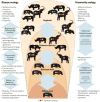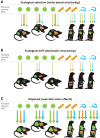Why infectious disease research needs community ecology
- PMID: 26339035
- PMCID: PMC4863701
- DOI: 10.1126/science.1259504
Why infectious disease research needs community ecology
Abstract
Infectious diseases often emerge from interactions among multiple species and across nested levels of biological organization. Threats as diverse as Ebola virus, human malaria, and bat white-nose syndrome illustrate the need for a mechanistic understanding of the ecological interactions underlying emerging infections. We describe how recent advances in community ecology can be adopted to address contemporary challenges in disease research. These analytical tools can identify the factors governing complex assemblages of multiple hosts, parasites, and vectors, and reveal how processes link across scales from individual hosts to regions. They can also determine the drivers of heterogeneities among individuals, species, and regions to aid targeting of control strategies. We provide examples where these principles have enhanced disease management and illustrate how they can be further extended.
Copyright © 2015, American Association for the Advancement of Science.
Figures




References
-
- Sepúlveda J, Murray C. The state of global health in 2014. Science. 2014;345:1275–1278. - PubMed
-
- World Health Organization. The Top 10 Causes of Death. 2014 www.who.int/mediacentre/factsheets/fs310/en.
Publication types
MeSH terms
Grants and funding
LinkOut - more resources
Full Text Sources
Other Literature Sources
Medical

